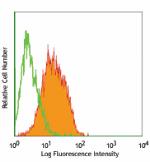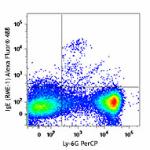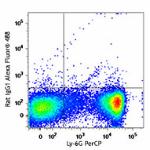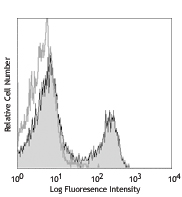- Clone
- RME-1 (See other available formats)
- Regulatory Status
- RUO
- Other Names
- Immunoglobulin E
- Isotype
- Rat IgG1, κ
- Ave. Rating
- Submit a Review
- Product Citations
- 12 publications
| Cat # | Size | Price | Quantity Check Availability | Save | ||
|---|---|---|---|---|---|---|
| 406903 | 50 µg | 76€ | ||||
| 406904 | 500 µg | 184€ | ||||
The RME-1 monoclonal antibody reacts with immunoglobulin E (IgE) in all tested mouse haplotype (Igh-a and b). It does not react with other isotypes. The RME-1 monoclonal antibody may be used as primary or secondary reagent for ELISA or immunofluorescent analysis.
Product DetailsProduct Details
- Verified Reactivity
- Mouse
- Antibody Type
- Monoclonal
- Host Species
- Rat
- Immunogen
- Mouse Ig cocktail, including IgE
- Formulation
- Phosphate-buffered solution, pH 7.2, containing 0.09% sodium azide.
- Preparation
- The antibody was purified by affinity chromatography, and conjugated with biotin under optimal conditions.
- Concentration
- 0.5 mg/ml
- Storage & Handling
- The antibody solution should be stored undiluted between 2°C and 8°C. Do not freeze.
- Application
-
ELISA, FC
- Recommended Usage
-
Each lot of this antibody is quality control tested by ELISA. For ELISA capture, the suggested use of this reagent is ≤2.0 µg per ml. It's recommended that the reagent be titrated for optimal performance for each application.
- Application Notes
-
This clone also recognizes IgE when bound to FceRI.
- Application References
-
- Jeong KT, et al. 2012. Int Immunopharmacol. 13:377. PubMed
- Product Citations
-
- RRID
-
AB_315074 (BioLegend Cat. No. 406903)
AB_315075 (BioLegend Cat. No. 406904)
Antigen Details
- Biology Area
- Immunology
- Gene ID
- 380792 View all products for this Gene ID
- UniProt
- View information about IgE on UniProt.org
Related FAQs
- How many biotin molecules are per antibody structure?
- We don't routinely measure the number of biotins with our antibody products but the number of biotin molecules range from 3-6 molecules per antibody.
Other Formats
View All IgE Reagents Request Custom Conjugation| Description | Clone | Applications |
|---|---|---|
| Biotin anti-mouse IgE | RME-1 | ELISA,FC |
| Purified anti-mouse IgE | RME-1 | ELISA,FC |
| FITC anti-mouse IgE | RME-1 | FC |
| PE anti-mouse IgE | RME-1 | FC |
| Alexa Fluor® 488 anti-mouse IgE | RME-1 | FC |
Customers Also Purchased



Compare Data Across All Formats
This data display is provided for general comparisons between formats.
Your actual data may vary due to variations in samples, target cells, instruments and their settings, staining conditions, and other factors.
If you need assistance with selecting the best format contact our expert technical support team.
-
Biotin anti-mouse IgE
-
Purified anti-mouse IgE
-
FITC anti-mouse IgE

IGEL cell line stained with RME-1 FITC -
PE anti-mouse IgE

IGEL-a2 cell line (IgE producing mouse hybridoma) stained wi... -
Alexa Fluor® 488 anti-mouse IgE

C57BL/6 mouse bone marrow cells were stained with CD45 PE, L... 

 Login / Register
Login / Register 












Follow Us